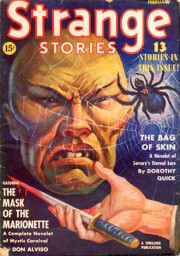 One of the short-lived competitors to Weird Tales was the magazine Strange Stories. Strange Stories lasted for 13 issues from February 1939 to February 1941. It was a bimonthly publication from Better Publication who put out the “Thrilling” line of pulp magazines. An issue costs 15 cents and probably is the reason Weird Tales dropped its price from 25 cents to 15 cents.
One of the short-lived competitors to Weird Tales was the magazine Strange Stories. Strange Stories lasted for 13 issues from February 1939 to February 1941. It was a bimonthly publication from Better Publication who put out the “Thrilling” line of pulp magazines. An issue costs 15 cents and probably is the reason Weird Tales dropped its price from 25 cents to 15 cents.
The contents contain familiar names from Weird Tales– Robert Bloch, Henry Kuttner, C. L. Moore, Carl Jacobi, E. Hoffmann Price. There were also some pseudonyms from the Thrilling magazines such as “Keith Hammond” and “Will Garth.”
Some sword and sorcery got mixed into the contents of the magazine. Henry Kuttner’s two “Prince Raynor” stories being the best known. A more obscure sword and sorcery story showed up in the February 1940 issue- “Singing Blades” by Lloyd Arthur Eshbach.
Lloyd Arthur Eshbach (1910-2003) was typical science fiction fan turned writers of the 1930s. He like others faded out from writing in the 1940s. He 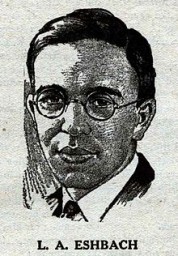 was in Wonder Stories, Amazing Stories, one story in Weird Tales, and small press zines such as Marvel Tales and Fantasy Magazine.
was in Wonder Stories, Amazing Stories, one story in Weird Tales, and small press zines such as Marvel Tales and Fantasy Magazine.
Eshbach had two stories in Strange Stories, both in 1940, “Singing Blades” and “The Cauldron.” “Singing Blades” (February 1940) starts out with Malcolm McLoen, an American who is a second generation Scot wandering the Scottish Highlands.
“On still and starlit nights, when warm breezes whisper over Scottish moor, stroking the benty blue grass, caressing the heather, one can hear the singing blades. High and clear, yet faint as a fairy sound, their song rises from the shores of a woodland burn or a hidden loch–high and clear, like the chime of distant bells. Yet, oddly enough, the elfin melody is hear only by those who do not seek it; when one listens, it dies in the solitude of lonely hills.”
While in an oak forest, he has visions of himself fighting with a bronze sword. One vision had him burying his sword under a rock. He finds a rock fort and recognizes the spot where his earlier incarnation buried the sword. Sure enough, he finds the sword.
A storm from the North Sea drives him to find shelter in a circular tower (probably a broch). A tall, hooded, menacing figure is present, Caermarthen, the last druid. Caermarthen recognizes the sword that Malcolm carries. A sword fight ensues in which Malcom becomes Cinel Loarn of the Sidhe, a previous life. Carmarthen is finally dispatched. A row of swords and shields reveal themselves to be other Sidhe imprisoned within the weapons.
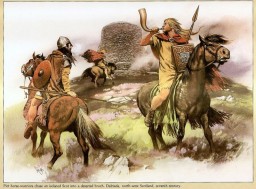
The story is a little bit of a mess as Eshbach seems to like Celtic legend and history but did not know it well. He conflates the Sidhe of Irish mythology with the Pechts (i.e. Picts) of Scotland/Alba. One of the flashbacks has Goidels (i.e. Gaels/Irish) as blue painted savages. The Picts supposedly painted themselves blue using woad. The druids are used as generic sorcerous bad guys in the same manner as Robert Bloch’s usage. Eshbach was a Pennsylvania Dutchman from Reading so Celtic mythology was not part of his genetic or cultural heritage.
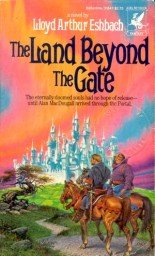 Eshbach later incorporated “Singing Blades” as the prologue for the novel The Land Beyond the Gate (Del Rey Books, 1984).
Eshbach later incorporated “Singing Blades” as the prologue for the novel The Land Beyond the Gate (Del Rey Books, 1984).
Lloyd Arthur Eshbach attended Pulp-Con in 1997 where I met him. I sent him a copy of Engor’s Sword Arm by David C. Smith which I had just published. He gave me a call and I asked him what was the influence for “Singing Blades” and “The Cauldron.” He told me the stories by Fiona MacLeod. MacLeod was actually William Sharp who wrote under a female pseudonym. Many of the stories are in a British Isles Celtic never land. Some are violent tales of struggles with Norseman and evil sorcerous femme fatales.
“Singing Blades” was reprinted (as was “The Cauldron”) in Tyrant of Time from Fantasy Press (Eshbach’s publishing venture). Copies should be available inexpensively online.
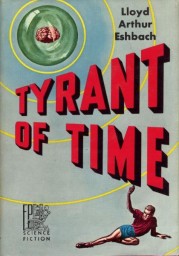
So many authors to read due to this site! How am I to get enough time for this and all the writing I should be doing?